Implementing Change Management and Adoption Processes
Many business leaders report that managing the change associated with improvement initiatives and technology implementations presents them with their biggest challenges. When the change relates to pricing, the obstacles can be even greater as the effort can be emotionally charged. Practices that are deeply rooted in a company's history may be challenged, and individual compensation may be affected. All of these factors can inspire organizational resistance. Some of the obstacles that must be overcome follow.
- Convincing stakeholders about the value of pricing and its validity as a discipline. As a relatively new corporate function, pricing's importance tends to be undervalued by established business disciplines such as finance, marketing, and research and development (R&D), which discourages cooperation at many levels.
- Implementing data-driven pricing techniques in the field. Calculating profitability and other metrics in real time often requires changes to unify technology, business processes, and culture. Yet sales professionals are notoriously reluctant to change how they are compensated, adopt new tools, and accept additional oversight and guidance.
- Fostering cross-functional collaboration. Pricing activities are typically scattered throughout an organization, and most businesses struggle to find a way to get loosely connected employees with pricing responsibilities to realize their shared mission and work together to realize corporate profitability goals.
- Persuading stakeholders that change is necessary. Most organizations erroneously believe they are doing a good job on pricing. Unless they are provided with compelling evidence to the contrary, they will continue to resist efforts to adjust current practices.
Effective change management and adoption requires execution of four key steps, described in Table 6.1.
Table 6.1 Change Management and Adoption Activities
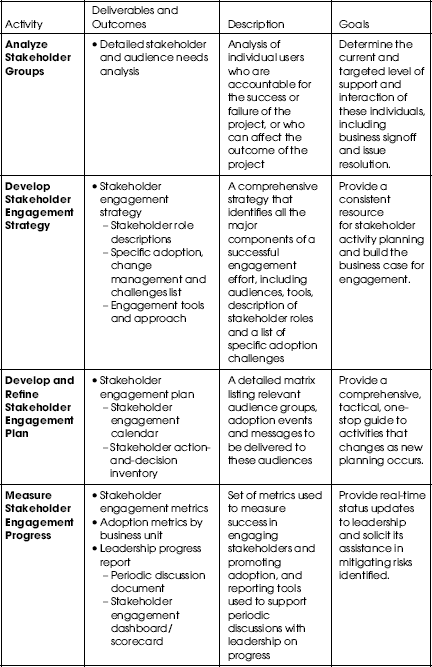
Effective communication with stakeholders is critical to winning their whole-hearted support. Unlike the implementation of new quality assurance (QA) or customer relationship management (CRM) systems—technologies with well-established track records—pricing initiatives usually require management to develop a powerful business case for change. This should include a careful delineation of both financial and non-financial benefits to overcome internal objections.
The primary reason employees resist change is because they do not understand how it will impact them personally. Most businesses have active rumor mills, which contribute to fears that a sweeping reorganization will affect job security, compensation levels, and daily work habits. Clear, frequent communications are essential. Management must explain to employees how they will be affected; how they will benefit from the changes.
In essence, change management efforts seek to move stakeholders—individuals and groups—up the commitment curve (see Figure 6.5), from contact to internalization, as they increasingly accept the initiative.
Figure 6.5 Commitment Curve
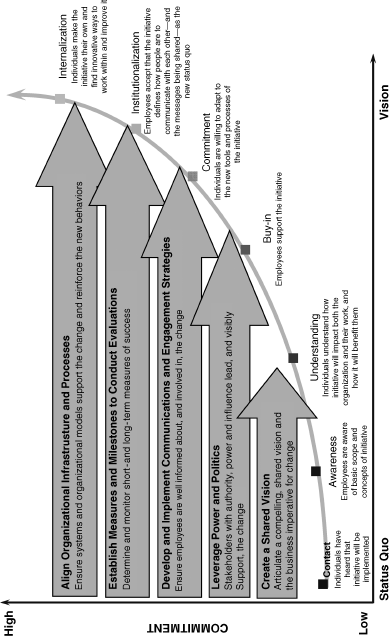
Communications must go through both top-down and bottom-up channels. Firms that choose just one channel risk having their message distorted, misheard, or ignored. For example, if executives simply issue memos to senior pricing leaders and expect them to pass the messages down through the ranks, then this could make people on the front lines of the pricing changes feel slighted and disenfranchised. On the other hand, if pricing managers thoroughly brief lower-level pricing employees without first separately briefing corporate leadership, then they risk losing the executive buy-in and sponsorship that is absolutely necessary for any transformative change to be successful.
The corporate culture can also present challenges to change management. For example, if individual performance rather than group success has traditionally been rewarded, then change may be resisted. Top salespeople may expect to do very well even if their colleagues have performed poorly over a quarter or a year. This could be such a deeply ingrained cultural characteristic that attempting to change it during a pricing reorganization would be a futile endeavor. As a general rule, firms should map their pricing organizations and strategies to the existing corporate culture, not the other way around. All stakeholders should receive training to facilitate adoption of changes; training, for example, on new software, selling on value, instituting decision-making procedures, and following reengineered pricing processes.
To execute a successful change and adoption initiative, all the individuals and groups who will be affected should be profiled and thoroughly understood.
Conducting a Stakeholder Assessment
Who are your stakeholders? Where do they reside organizationally? What are the issues that could get in the way of successful change? A stakeholder assessment can help answer these questions and guide the development of an effective engagement strategy.
As previously discussed, pricing professionals are found throughout Sales, Marketing, and Finance, as well as in other areas such as Customer Service, Purchasing, and Supply Chain. To identify all affected stakeholders, firms should:
- confirm that any high-level overview of the organization has considered every department
- examine each department carefully to determine which subgroups are stakeholders
- identify key leaders in each department (and subgroup, if needed) who are critical to the success of the pricing initiative.
To determine whether an entire group should be identified as a stakeholder, consider the following:
- Will changes in the pricing organization affect it in any way?
- Will the individuals within the group find their day-to-day activities affected?
- Does the firm need support from this group to achieve success?
Once the stakeholder groups have been identified, each should be evaluated against key criteria (e.g., size, specific role in the pricing organization, resource requirements, and the impact the change will have on its members) to consider its needs and—more important—to assess its potential to disrupt or impede the desired changes (see Table 6.2).
Table 6.2 Stakeholder Analysis Criteria
| Criteria | Definitions and Ratings |
| Current State of Awareness | Assigns H [high), M (medium), L (low) ratings, reflecting each stakeholder's current knowledge of the project or impending change |
| “To Be” Awareness | Assigns H (high), M (medium), L (low) ratings, reflecting desired level of knowledge regarding the project or impending change that each stakeholder should acquire in order for the project or impending change to be successful |
| Importance to Success | Assigns H (high), M (medium), L (low) ratings, reflecting each stakeholder's ability to impact the success of the project or impending change |
| Expected Behavioral Change | Assigns H [high), M (medium), L (low) ratings, reflecting the amount of expected behavioral change that each stakeholder will experience (i.e., impact on day-to-day activities) |
| Perception | Assigns P (Positive), T (Neutral), N (Negative) ratings, reflecting the stakeholder's attitude toward the initiative |
| Information Needs | The type of information required by the stakeholders to help them understand the effort and to engage them in the change |
| Individuals and Groups They Influence | The relationships between stakeholders that may positively or negatively influence the success of the project |
The results of the stakeholder analysis can be prioritized and summarized in a stakeholder map and an engagement strategy: these visually depict all stakeholders and how they should be engaged to ensure success. In the example stakeholder map shown in Figure 6.6, three different types of stakeholders are shown. They are categorized according to their required level of awareness and the degree to which their approval is necessary for the pricing changes to succeed. Figure 6.7 illustrates the engagement strategy that should be pursued with each group.
Figure 6.6 Stakeholder Map (Size of Bubbles Represents Stakeholder Group Size)

Figure 6.7 Stakeholder Map and the Engagement Strategy for Each Group
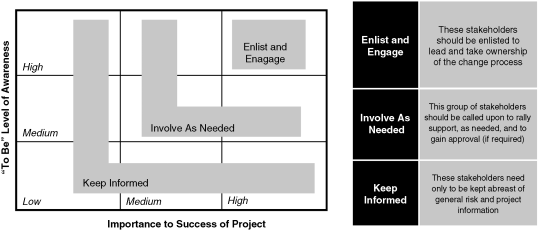
The stakeholder analysis can bring to light interdependencies between groups and help assess the risks associated with the implementation of planned changes. Firms should also assess the change readiness of the stakeholders and determine the most effective communication option to reach them. For example, one global manufacturing firm had recently lost almost 50 percent of its customer service division due to turnover and because the manufacturer was cutting costs, and the remaining personnel had literally no time to devote to implementing a new pricing structure. However, by engaging pricing specialists from other functional areas to step in and assist the customer service representatives, the firm was able to carry out the restructuring successfully without overburdening the customer service division.
Developing a Stakeholder Engagement Plan
The stakeholder analysis will define the outcomes expected for each group and make the case for change (see Table 6.3).
Table 6.3 Stakeholder Groups and Expected Outcomes
| Group | Expected Outcomes |
| Business Unit Leadership Group | • Demonstrate visible project support to all employees • Facilitate and cascade communications to all employees • Collect feedback from all employees • Model new behaviors and promote buy-in among all employees |
| Pricing Leadership Groups (Leaders of All Affected Areas: Sales, Marketing and Others) |
• Demonstrate visible project support to managers, power users and end users • Facilitate and cascade communications to managers, power users, and end users • Collect feedback from managers, power users, and end users • Model new behavior and promote buy-in among managers, power users, and end users • Designate participants and ensure appropriate resourcing for Pricing activities (e.g., transition projects and testing) • Assist in execution of change activities and resolution of related challenges • Ensure employee enrollment in, and completion of, training |
| Pricing Manager Groups (Managers of All Affected Areas: Sales, Marketing and Others) |
• Demonstrate project support to power users and end users • Facilitate and cascade communications to power users and end users • Collect feedback from power users and end users • Model new behavior and promote buy-in among power users and end users • Participate in Pricing activities (e.g., transition projects and testing) • Assist in execution of change activities and resolution of related challenges • Validate enrollment in, and completion of, training |
| Power Users | • Demonstrate project support among end users • Provide peers and end users with regular, informal Pricing updates • Gather informal feedback from power users and end users • Model use of new procedures and technology among end users • Participate in Pricing activities (e.g., transition projects and testing) • Assist in execution of change activities and resolution of related challenges • Work with training team to develop practice exercises and business scenarios • Receive training and then train end users in turn |
To minimize confusion during the restructuring and to help maximize effectiveness later on, a stakeholder engagement plan should be developed (see Table 6.4). This plan should detail the overall strategy for involving key groups and for achieving expected outcomes. Key themes and messages should be refined for each stakeholder to address the “What is in it for me?” questions tied to implementation (the benefits). Firms should also determine what activities should be used to reinforce them. This frequently involves training. If employees will be expected to use a new tool or template, then conducting a workshop—whether online, via teleconference, or in an onsite meeting—can be helpful.
Table 6.4 Stakeholder Engagement Plan

Implementing a Well-Designed Communications Plan
A strong communications plan helps engage stakeholders (see Figure 6.8 for an illustration of the communications process). The plan should keep all affected employees up to date on every element of the restructuring by:
Figure 6.8 Effective Communication Process
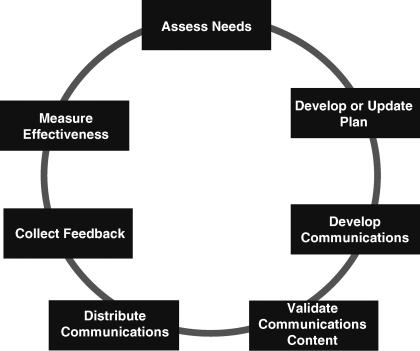
- Identifying the key messages needed to execute the pricing program. This includes the message date, delivery mechanism (e.g., email, memo, telephone call, or webinar), message owner, and audience.
- Proactively communicating key project messages, milestones, and upcoming events. Repetition is key. Firms should begin issuing memos months in advance of planned changes and reiterate the timeline, the extent of the changes, and the expectations for each stakeholder. Employees should be given sufficient time to adjust to the changes and to ask any questions they may have. Communications should include high-level messaging about strategic direction as well as tactical instructions on how changes will play out on a very practical level.
- Publicizing the training schedule. As part of the communications plan, firms should notify stakeholders about training classes, workshops, documentation, and other resources that will enable them to transition to the new ways of doing things.
Table 6.5 identifies the type of information that should be captured in a communications plan, and what vehicles should be used to reach each audience. Table 6.6 shows an example communications plan.
Table 6.5 Communication Plan Elements
| Element | Description |
| Stakeholder Group | Who is the target audience for the communication activity or event? |
| Objective | What is the purpose of the communication activity or event? |
| Key Message | What are the content and sources of information? |
| Vehicle | What is the appropriate method for distributing content to particular stakeholder groups? |
| Frequency | How many times (or on what date) will the communication activity or event occur? |
| Feedback Mechanism | How is feedback being gathered on the communication activity or event? |
| Developer | Who is creating the communication material? |
| Reviewer and Signoff | Who reviews and signs off on the communication material? |
| Status | What is the status of the communication activity? |
| Release Date | When will this communication be delivered to the identified stakeholder group? |
| Signoff Date | When does the leadership team need to sign off on this communication material? |
Table 6.6 Pricing Communications Plan
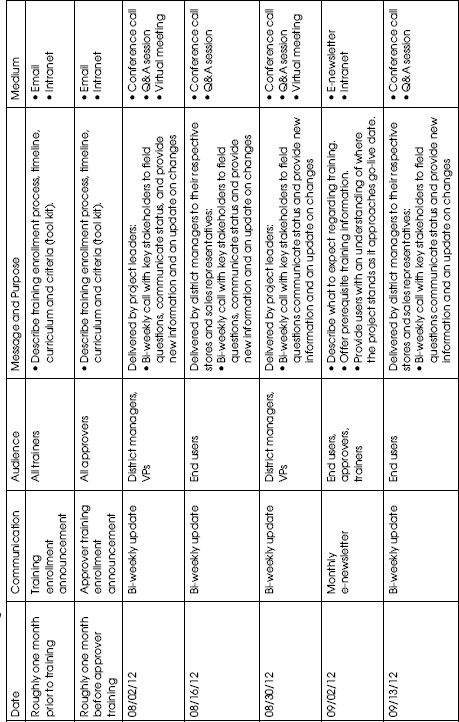
The objectives of a communications plan are as follows.
- Build understanding and support for the pricing improvement effort by establishing forums for discussion.
- Strengthen the communications capabilities of managers and leaders by providing resources and tools (including frameworks, guidelines, and key talking points) to facilitate a consistent dialogue with stakeholders.
- Support employees and managers as they adjust their activities and work processes to meet reconfigured (and clearly defined) expectations and benefits.
- Build commitment, ownership, and trust.
- Monitor and measure feedback.
- Use lessons learned to plan other communications efforts.
- Accelerate adoption, engagement, and commitment to use the new tools to achieve pricing benefits.
Reinforcing the Pricing Changes
Too often, a company will do almost everything right when planning for and implementing a major pricing transformation, but because the company fails to put mechanisms in place to ensure that messages and training stick, employees forget what they have learned, stop using the new processes and tools, and return to their old habits.
Continual reinforcement must be an essential part of any change management plan; it is a crucial weapon in the battle against organizational regression. Firms can reinforce through a variety of methods, including refresher lunch and learn sessions, monthly feedback forums, and focused training on advanced topics. Firms must also anticipate how to deal with stubborn resistance among some employee groups. If this happens, stakeholders should be reminded that their job performance, and perhaps even their compensation, will be impacted if they do not adopt the changes.
A global specialty materials company spent many millions of dollars formulating a new pricing strategy and putting supporting processes in place. Despite investing such a significant sum of money, the firm neglected to establish mechanisms to ensure that employees were actually adopting the new tools and processes. As a result, the firm realized less than 20 percent of the return on investment (ROI) it had expected for its pricing transformation.
